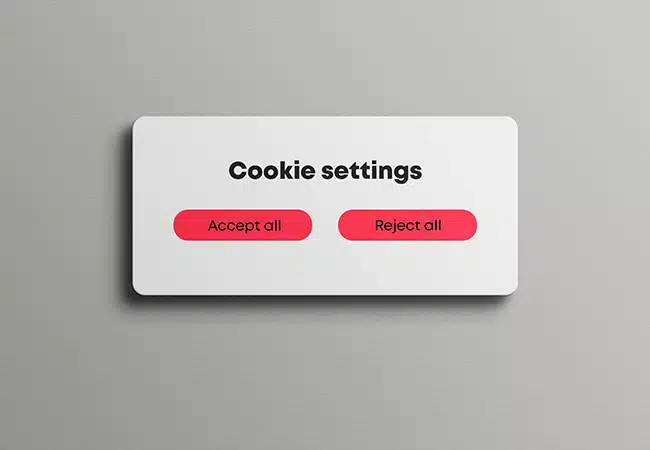What is a cross-domain cookie?
Posted: August 2, 2023
Cookie banners – love them or hate them – are there to serve a fundamental purpose: gaining user consent to store data related to a user’s interaction with any given website. Whilst they’re vital for ensuring compliance, they can severely impact the user experience when done poorly.
Whenever you’re online, you’re relying on the website to provide you with a seamless browsing experience.
Central to improving this experience there are various technologies that enable data sharing between different domains. One such technology that plays a pivotal role in this ecosystem is cross-domain cookies.
So let’s explore what they are and how your organization can use them to optimize the user experience…
- Understanding the types of cookies
- Diving deeper: What is a cross-domain cookie?
- The benefits of cross-domain cookies
- Considerations and security measures
Understanding the types of cookies
Before delving into cross-domain cookies, let’s refresh our understanding of cookies. Cookies are small text files that are stored on a user’s device by their web browser. They serve as a means to store various types of data related to a user’s interaction with a website.
This data can include user preferences, session information, authentication tokens, and more. Cookies play a crucial role in personalizing user experiences, maintaining user sessions, and enabling features like shopping carts in online stores.
Key types of cookies:
Session cookies: Session cookies are temporary cookies that are stored in a user’s browser for the duration of their browsing session. They are typically deleted once the user closes the browser. These cookies are often used to store temporary information such as user preferences, items in a shopping cart, or data required to maintain a user’s login session.
Persistent cookies: Unlike session cookies, persistent cookies remain on the user’s device even after they close the browser. These cookies have an expiration date set by the website, which determines how long they will remain on the user’s device. Persistent cookies are used for purposes like remembering login credentials, tracking user preferences across sessions, and providing personalized experiences.
Secure cookies: Secure cookies are designed to be transmitted only over encrypted (HTTPS) connections. They help ensure that sensitive data stored in cookies, such as login credentials or authentication tokens, is transmitted securely between the user’s browser and the website’s server.
HttpOnly cookies: HttpOnly cookies can only be accessed by the server and are not accessible via client-side scripts like JavaScript. This adds a layer of security against cross-site scripting (XSS) attacks, where malicious scripts try to access sensitive data stored in cookies.
Same-site cookies: Same-Site cookies specify whether cookies should be sent with cross-origin requests under three options (strict, lax and none).
Third-party cookies: Third-party cookies are set by domains other than the one the user is currently visiting. They are often used by advertisers and tracking services to monitor user behavior across different websites. Third-party cookies have raised privacy concerns, leading to changes in browser policies that limit their usage.
Cross-domain cookies: Cross-domain cookies can be shared and accessed across multiple domains. They are often used for purposes like Single Sign-On (SSO) and data sharing between related websites.
Diving deeper: What is a cross-domain cookie?
Cross-domain cookies, as the name suggests, are cookies that can be shared and accessed across multiple domains.
Traditional cookies are typically associated with a single domain, meaning they can only be read and manipulated by the website that set them.
However, cross-domain cookies break down this siloed approach, enabling data sharing and communication between websites hosted on different domains.
The benefits of cross-domain cookies
The primary purpose of cross-domain cookies is to facilitate seamless interactions between websites that are part of the same ecosystem or have a collaborative relationship. This technology unlocks a range of benefits:
- Reduce consent fatigue: As discussed, cookie banners can be frustrating and impede the user journey. For some brands, it could be relevant or useful to utilize cross-domain cookies to share consent preferences between linked websites. This means the banner will appear once, then should the user navigate to another website with cross-domain cookie sharing, their cookie consent will be remembered, and the banner will not reappear.
- Single Sign-On (SSO): Cross-domain cookies are often employed to enable Single Sign-On functionality. Users can log in to one website and then navigate to other websites within the same network without needing to re-enter their credentials. This streamlined experience enhances user convenience and encourages cross-site engagement.
- Personalization across domains: Cross-domain cookies enable websites to share user preferences and behavior data, leading to a cohesive and personalized browsing experience. For instance, an online retailer could share a user’s browsing history and shopping cart data with a related fashion blog, offering tailored recommendations.
- Tracking user journeys: When different websites within a network can access cross-domain cookies, it becomes easier to track a user’s journey across multiple touchpoints. This information is invaluable for marketers and website owners to better understand user behavior and optimize their strategies.
Considerations and security measures
While cross-domain cookies offer several advantages, they also come with considerations and potential security concerns. As with anything to do with user data, you need to take care and do your due diligence to maintain trust and ensure compliance with any relevant legislation.
Privacy implications: The sharing of user data across domains raises privacy concerns. Users might not be comfortable with their information being shared between websites without clear consent and understanding of how their data will be used.
Security risks: If not implemented carefully, cross-domain cookies could be exploited by malicious actors to gain unauthorized access to user data. Proper encryption and authentication mechanisms are crucial to mitigate these risks.
User consent and control: Websites employing cross-domain cookies must prioritize transparency and user control. Providing clear information about data sharing practices and giving users the ability to opt in or out is essential.
Cross-domain cookies are a powerful tool that enables enhanced collaboration and a more seamless online experience for users. They enable single sign-on, facilitate data sharing for personalization, and allow for better tracking of user journeys across multiple websites.
However, their implementation requires careful consideration of privacy and security concerns. Working with a consent management platform that can implement these for you without risking non-compliance is essential.
As we see the depreciation of third-party cookies and user-experience expectations continue to evolve, cross-domain cookies will likely remain a central element in the pursuit of creating unified, user-centric online experiences.

85% of marketers are concerned about the potential impact of data privacy legislation changes
Changes in data privacy legislation ending third-party cookies could require us to rethink our strategies for reaching our customers. Read our Privacy pain points report to learn about marketers’ growing data privacy concerns.

